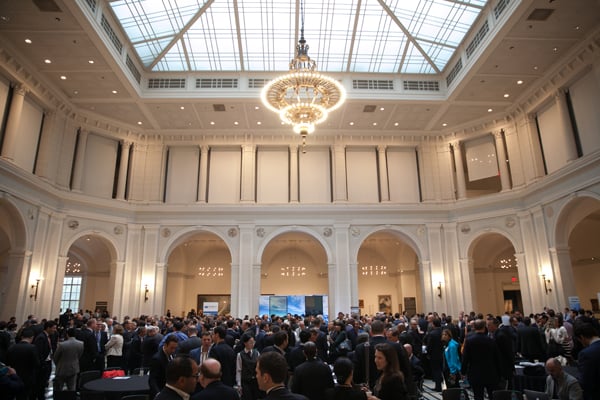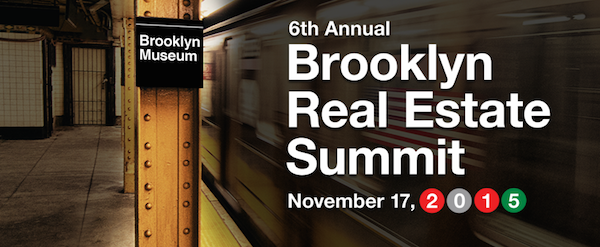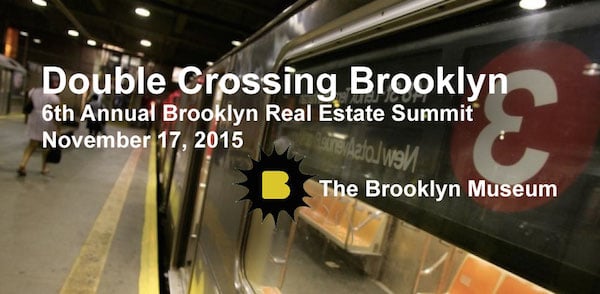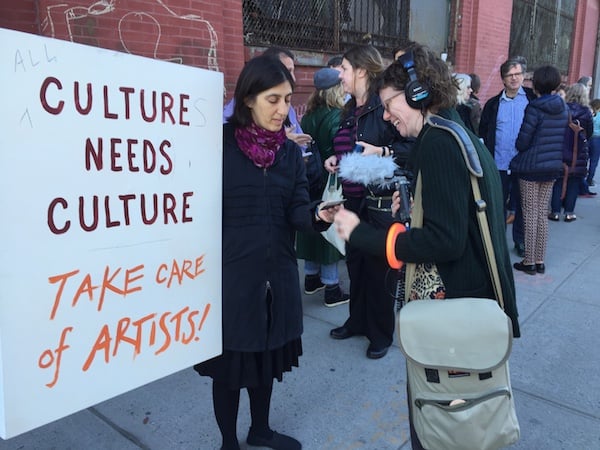Opinion
The Brooklyn Museum Should Evict the Brooklyn Real Estate Summit
Hundreds of artists are standing up to gentrification.

Image: via conference website
Hundreds of artists are standing up to gentrification.

Ben Davis

On November 17, people will be protesting outside the Brooklyn Museum. You should be too. I certainly will be.
That’s the day that the museum will be playing host to the all-day Brooklyn Real Estate Summit, where, for $500 a ticket, over 800 developers will converge to hobnob and plan new ways to jack up your rent.
If you want to get mad, hop on over to the summit’s website. The agenda advertises that it will help you learn how “to find overlooked neighborhoods to invest in;” teach you “what you need to know about the latest batch of newcomers;” and provide tips on attracting sources of “international and institutional capital” to fuel the gentrification machine.

The cover graphic for the Brooklyn Real Estate Summit.
Image: via conference website.
Everyone I know who has seen the agenda for the summit has their own favorite panel title to hate-share. My personal favorite is the afternoon session on “Mixed Use Strategies for Retaining Brooklynites.”
Reading over the title, I briefly thought it was some kind of fleeting, tokenistic gesture at social conscience. Like a human, I thought “retaining Brooklynites” might mean preserving the fabric of existing Brooklyn communities.
As it turns out, it concentrates on how to keep wealthy shoppers in the borough rather than going to Manhattan to satisfy their desire for boutique goods and services. Possible discussion topics include: “What mixed use projects are coming online to capture the hearts, minds and wallets of the new Brooklyn residents?”

Screen capture of the Brooklyn Real Estate Summit conference agenda.
Image: via conference website.
The Brooklyn Anti-Gentrification Network has been petitioning in front of the museum for the past two weekends; last week, it set up an online petition against the summit, and plans for a full-blown protest next Tuesday. Other community groups, including the Artist Studio Affordability Project (ASAP), have gotten on board, and a bunch of artists and writers like myself have a letter to the museum asking them to cancel the summit (you can sign ASAP’s letter here).
More than 700 have already signed ASAP’s letter. These include quite a few artists who are in the Brooklyn Museum’s upcoming show dedicated to socially engaged art, “Agitprop!,” or the recent “Crossing Brooklyn:” Luis Camnitzer, Aisha Cousins, Beka Economopoulos (of Not An Alternative), Gordon Hall, Paul Ramirez Jonas, William Lamson, Shaun Leonardo, Lisa Sigal, Martha Rosler, Todd Shalom (of Elastic City), and Xaviera Simmons.
The Guerrilla Girls, whose work is featured in”Agitprop!,” have already confirmed that they will be at the protest. I hope many more will be there too.
A satirical protest/reception/exhibition called “Double Crossing Brooklyn” is being organized outside the museum during the networking hour of the summit.

Graphic for “Double Crossing Brooklyn” protest at the Brooklyn Museum.
Image: via “Double Crossing Brooklyn” Facebook event page.
Artists are just part of a broader coalition here, which is the way it should be. Nevertheless, I want to make an appeal that is specific to the art community, for two separate but interconnected reasons.
One is that gentrification is crushing the conditions for making art in New York. Consciousness of this reality has become so widespread that it has moved well beyond the typical Joan Didion-esque “Why I am leaving New York” screed. It is indeed hard to have any honest conversation about the arts without addressing it.
Consider the Center for an Urban Future’s Creative New York report, which is meant to tout New York’s advantages as a creative capital. The 2015 report, however, doubles as an alarm, summed up by a quote from playwright Robin Frohardt: “The speed at which rents are rising, there won’t be any artists here in 20 years.”
Consider MoMA PS1’s “Greater New York” survey, which is likewise supposed to be a celebration of New York’s artistic vitality but somehow has an overall dark mood this year. Visitors to the show are greeted with a dire text by curators lamenting how today’s scene is stricken by “a voracious real estate market that poses particular challenges to local artists.”
Just a few weeks ago, hundreds of artists received word that they were being ejected from their Gowanus studios. Industry City, a complex in Sunset Park, also experienced a significant shake-up not that long ago, when dozens of artists were displaced by rising rents. (Guess who was a featured speaker at last year’s Brooklyn Real Estate Summit? Industry City boss Andrew Kimball.)

Artists protesting eviction in Gowanus.
Image: Ben Davis.
But we have to be honest about something, too, and this is the second point: “Artists” is often an unexamined code for college-educated, creative-class types, disproportionately white and disproportionately from middle-class backgrounds. The hip “new Brooklyn.”
As Imani Henry of the Brooklyn Anti-Gentrification Network emphasized to me: there are already artists living in neighborhoods before the “artists” move in to gentrifying neighborhoods. They are poets, street dancers, graffiti kids, muralists, musicians of all kinds, all the folks who make the Puerto Rican and West Indian parades still the city’s largest and most dynamic cultural events.
In other words, talk of “art and gentrification” often proceeds on the basis of having already, in effect, gentrified the idea of art. This is important. Studio artists may be struggling to hold on, but they are viewed, by the powers that be, as the bridge to an affluent and glamorous audience, gentrification’s amuse-bouche.
By hosting the Brooklyn Real Estate Summit, the Brooklyn Museum is actively helping to cement the connection of studio art and real-estate speculation in the eyes of the broader public. And believe me, it doesn’t take much.
That’s reason to stand up, whether or not you are facing displacement, if you are at all involved with or associated with New York’s art scene. If you feel angry about the way that art’s cachet has been used to brand neighborhoods and displace poor people and communities of color, well, here’s a way to take that cachet, and use it to amplify the voices of those struggles instead.
“We’re at a point now in this city where you really have to be political,” the artist Jenny Dubnau, who has been trying to organize artists through ASAP, told me over the phone last week. “Because if you don’t do anything, we’re talking about people’s lives being destroyed.”
In a way, the Brooklyn Real Estate Summit does us a favor. It puts a face on something—“gentrification”—that gets talked about in a too-abstract way, as if it were some natural process. Gentrification is planned, and here you have its planners, set to gather in the museum’s Great Hall and plot “The Next Stage in Brooklyn’s Development.” Literally.
I mean, one of the suggested Summit topics is “What opportunities for value-add exist in the seemingly picked-over areas?” They might as well just have written, “How can we suck the last marrow from the shattered bones of working class New York?” And then let out an evil laugh.
The relentless transformation of every available block in this city into a luxury playground will not stop until there is political will to change urban priorities in a major way. And that means that it will not stop if this gathering of sharks at the Brooklyn Museum goes on without a peep from the public.
Indeed, the response so far has already had an effect. Anne Pasternak, the new director of the museum who inherited the Summit, has offered to meet with protesters, to organize a community event on gentrification, and to review museum rental policies—not nothing, though it also feels like damage-control 101 to me.
The message here is simple: the Brooklyn Museum should not be hosting this event at all. I can’t think of a compromise on that that makes much sense. Unless it would be to quintuple the rent they charge the Real Estate Summit without warning, and make them leave that way, so that they know how the rest of us feel.